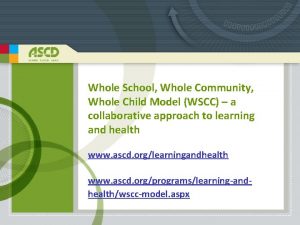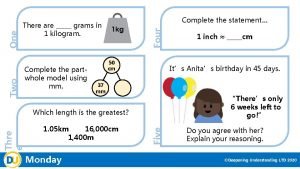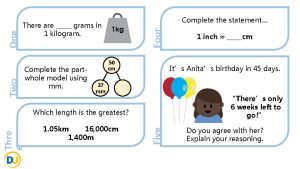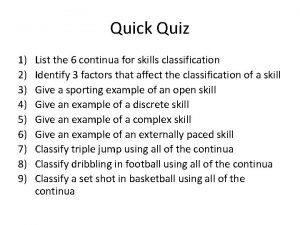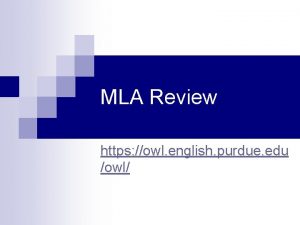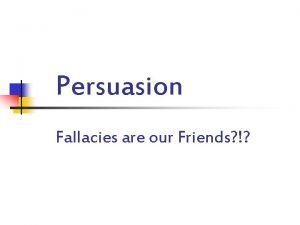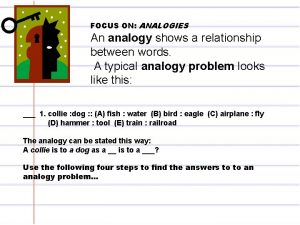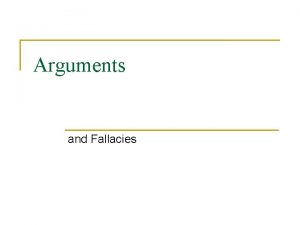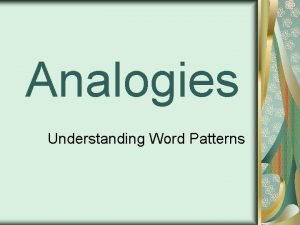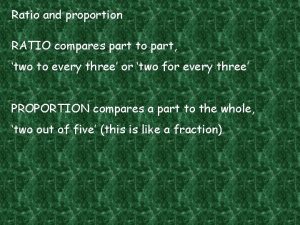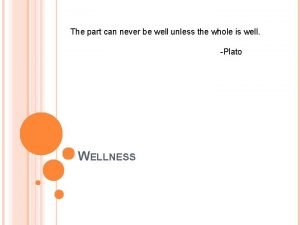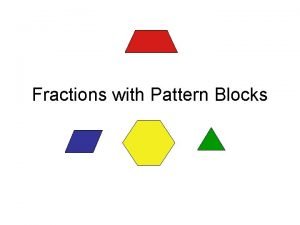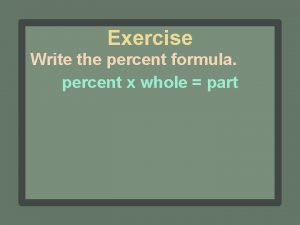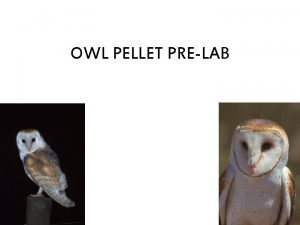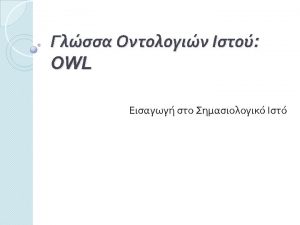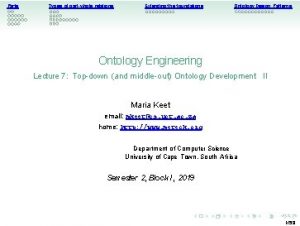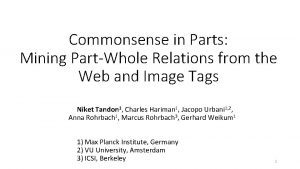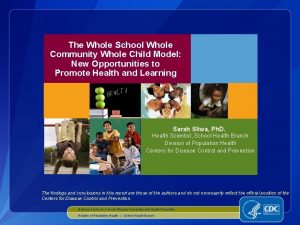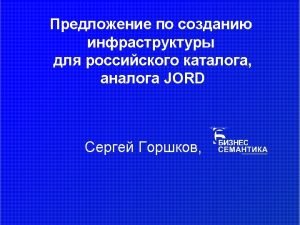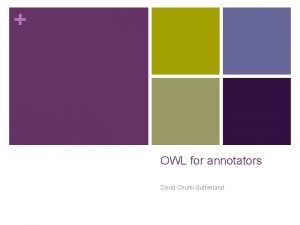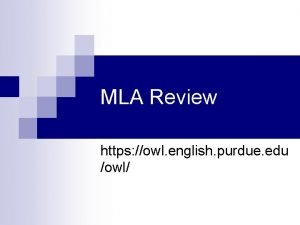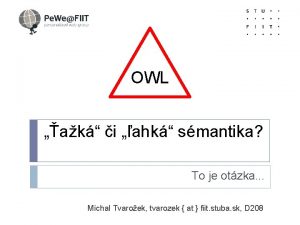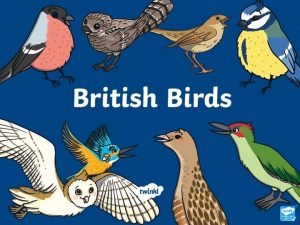Patterns Partwhole relations Part Whole relations OWL has






















- Slides: 22

Patterns: Part-whole relations

Part Whole relations ►OWL has no special constructs ►But provides the building blocks ►Transitive relations ►Finger is_part_of Hand is_part_of Arm is_part_of Body Finger is_part_of Body

Many kinds of part-whole relations ► Physical parts ► hand-arm ► Geographic regions ► Hiroshima - Japan ► Functional parts ► cpu – computer ► See Winston & Odell Artale Rosse

Simple version ►One property is_part_of ►transitive ►finger is_part_of some Hand is_part_of some Arm is_part_of some Body

Get a simple list ► Probe_part_of_body = Domain_category AND is_part_of some Body ► Logically correct ► But may not be what we want to see ►The finger is not a kind of Hand ►It is a part of the hand

Injuries, Faults, Diseases, Etc. ► A hand is not a kind of a body ► … but an injury to a hand is a kind of injury to a body ► A motor is not a kind of automobile ► … but a fault in the motor is a kind of fault in the automobile ► And people often expect to see partonomy hierarchies

Being more precise: “Adapted SEP Triples” ► Body (‘as a whole’) ► Body ► The Body’s parts ► is_part_of some Body ► The Body and it’s parts ► Body OR is_part_of some body ► Repeat for all parts ► Use ‘Clone class’ or ► NB: ‘JOT’ Python plugin is good for this

Adapted SEP triples: UML like view Injury to Arm (or part of arm) has_locus some Arm OR part of arm Part of Arm Injury to Hand has_locus some Hand Forearm

Adapted SEP triples: Venn style view Arm or parts of Arm Parts of Arm Fore Arm Hand

Resulting classification: Ugly to look at, but correct

Using part-whole relations: Defining injuries or faults ► Injury_to_Hand = Injury has_locus some Hand_or_part_of_hand ► Injury_to_Arm = Injury has_locus some Arm_or_part_of_Arm ► Injury_to_Body = Injury has_locus some Body_or_part_of_Body ► The expected hierarchy from point of view of anatomy

Part-whole relations & the property hierarchy

Different kinds of Part Whole note polyhierarchy to combine structure & function ► Generic localisation ► has_locus ► has_physical_location ► is_structural_part_of ►… ► Is_contained_in ► Is_part_of (generic) ► Is_clinically_part_of ► Is_functionally_part_of ► Is_structual-part-of ► Is_subdividion_of ► Is_defined_by ► Is_constituent_of ► is_contained_in

Simplified mono-hierarchy in OWL

Sufficient to support Clinician’s view: multiple “views” Pericardium is part of heart & Pericardiitis is a kind of Heart Disease Formally: The Brain is contained in the Cavity defined by the Cranium which is a structural part of the skull. Anatomist’s view: Pericardium is a distinct organ that develops separately from Heart Both views: The Brain is located in the skul but not part of the skull

Geographical regions and individuals ► Similar representation possible for individuals but more difficult ► and less well explored

Simplified view: Geographical_regions ► Class: Geographical_region ► Include countries, cities, provinces, … ► A detailed ontology would break them down ► Geographical features ► Include Hotels, Mountains, Islands, etc. ► Properties: ► Geographical_region is_subregion_of Geographical_Region ► Geogrpahical_feature has_location Geographical_Region ► is transitive is_subregion_of ► Features located in subregions are located in the region.

Geographical regions & features are represented as individuals ► Japan, Honshu, Hiroshima-ken, … ► Mt_Fuji, Hiroshima_Prince_Hotel, …

Facts* ► Honshu is_subregion_of has. Value Japan Hiroshima-ken is_subregion_of has. Value Honshu Hiroshima is_subregion_of has. Value Hiroshima-ken ► Mt_Fuji has_location has. Value Honsh Hiroshima_prince_hotel has_location has. Value Hiroshima-ken *with apologies for any errors in Japanese geography

Definitions ► Region_of_Japan = Geographical_region AND is_subregion_of has. Value Japan n Feature_of_Japan = Geographical_feature AND ( has. Location has. Value Japan OR has. Location has. Value Region_of_Japan )

In tools at this time ► Must ask from right mouse button menu in Individuals tab n better integration under development

Warning: Individuals and reasoners ► Individuals only partly implemented in reasoners ► If results do not work, ask ► Open World reasoning with individuals is very difficult to implement ► If it doesn’t work, try simulating individuals by classes ► Large sets of individuals better in “Instance Stores”, RDF triple stores, databases, etc that are restricted or closed world ► Ontologies are mainly about classes ► Ontologies are NOT databases
 Whole school whole community whole child model
Whole school whole community whole child model Partwhole
Partwhole Partwhole
Partwhole Whole part whole practice
Whole part whole practice Part whole model subtraction
Part whole model subtraction Brainpop ratios
Brainpop ratios Mla citation purdue
Mla citation purdue Example of bandwagon
Example of bandwagon Percent composition
Percent composition Example analogies
Example analogies Function analogies examples
Function analogies examples Fallacy of division examples
Fallacy of division examples Author write chef cook analogy
Author write chef cook analogy Radio and proportion
Radio and proportion The part can never be well
The part can never be well Hyponychium
Hyponychium The yellow hexagon is which part of the whole
The yellow hexagon is which part of the whole Percent x whole = part
Percent x whole = part In traditional dating patterns dating behavior
In traditional dating patterns dating behavior Associations and correlations in data mining
Associations and correlations in data mining Employee relations in public relations
Employee relations in public relations Part to part ratio definition
Part to part ratio definition Define technical description
Define technical description
